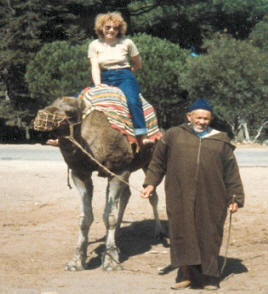|
||||||
|
Towns and Regions
Agadir,
The Atlantic coast line of Morocco is covered in silver sand beaches. Along this strip of sand is the resort town of Agadir. In addition to fabulous beaches, Agadir is ideal for sports lovers and enjoys a lively night life. It is also a good staging point for excursions to Taroudant, Tafraoute, Tiznit, Tata and Guellmim. Extremely popular with Europeans, this international resort has recently begun to be discovered by Americans.
Casablanca,
The center of commerce in Morocco, Casablanca boasts the largest port of the Maghreb, as that strip of Africa along the Mediterranean including Morocco, Algeria and Tunisia is called. It is a teeming, westernized city of somdeterminede 3.5 million people that looks much like Marseilles in France. It is here that King Hassan II to build one of the largest mosques in the world. The Hassan II Mosque has space for 100,000 worshipers and a 200-meter high minaret surmounted by a laser, which beams towards Mecca. Non-Muslims are welcome to visit this impressive monument. The city also has an elegant city center as well as the old and new medinas. |
|
|
Fez,
Built in the eighth century, much of Fez retains the atmosphere of earlier times. Karaouiine University, one of the oldest in the world, continues to contribute to Fez's reputation of the center of learning in Morocco. The maze of winding streets and covered bazaars located in the old part of the city offers up magnificent examples of Hispano-Arabic architecture as well as the activities of numerous craftsmen at work. Donkeys are still the main carriers of loads here, and Gnawa musicians dance, tassels spinning, through the streets, contributing to the excitement of the souk. Shopping is particularly good for carpets and ornate metalwork. Also in the medina is Ibn Danan, a traditional synagogue. A guide is recommended when visiting the medina as it is easy to get lost.
Fortified Cities,
Along the Atlantic coast are beautiful beaches, which surround towns fortified by battlements. Most famous of these is the resort of Essaouira, an eighteenth-century town characterized by white and blue houses and an easy style. It is the ideal place to relax and to stroll among its wood workshops and art galleries, boat builders and sardine fishermen, and to engage in the local sports of windsurfing and surfing. Among the souks worth visiting are the Marche d'Epices (spice market) and Souk des Bijoutiers (jeweler's market), which was once dominated by Imperial Cities, The Imperial Cities represent over a thousand years of unbroken royal succession. Unlike the rest of the Maghreb, Morocco was never invaded by the Turks and retains its cultural h eritage and a wealth of Islamic architecture. The Imperial Cities include Rabat, Meknes, Fez, and Marrakech. The Imperial Cities, particularly Fez and Marrakech, are unique in the Arab world, having retained a style of life that appears to have remain unchanged since medieval times
Kasbah Trail,
From Ouarzazate or Errachidia, travelers can go south along the Kasbah Trail, where the turreted "sand castles" rise up, one after the other. This picturesque area has provided locations for many a desert film. Visitors can enjoy the Moroccan tea ritual at a local kasbah or even spend the night. For those who prefer the comforts of a five-star hotel, the Meridien Berbere Palace offers a gracious atmosphere, with dinner served pool-side among the palms, and 232 air-conditioned rooms in villas surrounded by gardens. Past the Valley of the Draa, a 200-kilometer long oasis, is the desert. Not to be missed is the sun rising or setting over the sand dunes, called The Erg Chebbi, near Merzouga. Erfoud is a desert outpost where visitors can enjoy Moroccan bargaining at its best and most hospitable. The purchase of a quality hand-loomed Berber rug can take several hours and many cups of tea. Erfoud is a good stopping off point for trips to the dunes. The four-star Salam Hotel matches the ambiance of the town, complete with pool surrounded by palms where locals and guests sip cool drinks and room air conditioners labor to fight the heat and the sand.
Marrakech,
Founded in 1062, Marrakech was once the capital of an empire, which stretched from Toledo to Senegal. The city square, Djemmaa-el-Fna comes alive every evening with dancers, fortune tellers, musicians, and snake charmers. Just north of the square is a lively souk selling everything from stylish dresses to medicinal herbs. The Koutoubia mosque, which dates from the 12-century, dominates the Marrakech skyline. Not far from Marrakech is the village of Ourika, worth a day trip to visit its donkey market and country souk.
Mediterranean Coast,
The quintessential city of intrigue and romance, Tangier is the gateway to Morocco lying between the Atlantic Ocean and the Mediterranean Sea opposite Spain. During the day, visitors can enjoy the beaches, people watching in the cafes, and exploring the narrow streets of Tangier's medina. Tangier has the liveliest night life in Morocco. From here, adventurous travelers can visit the Rif Mountains and the city of Chefchaouen.
Meknes
Surrounded by 25 miles of battlements, Meknes reflects the genius of Sultan Moulay Ismail. The Tomb of Sultan Moulay, considered one of Morocco's most beautiful monuments, is open to non-Muslims. The souk of Meknes is characterized by exquisite displays of produce as well as the works of local craftsmen. About 20 miles from Meknes are the Roman ruins at Volubilis, where well-preserved excavations date back to the third century.
Rabat
|
|

